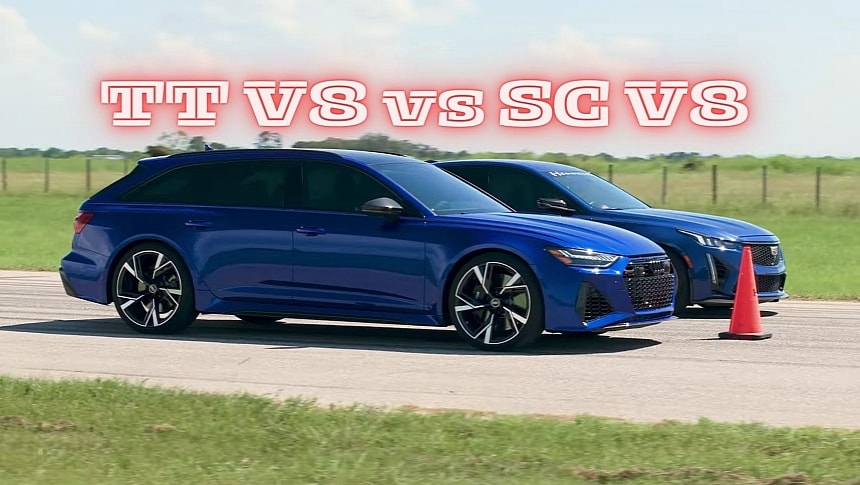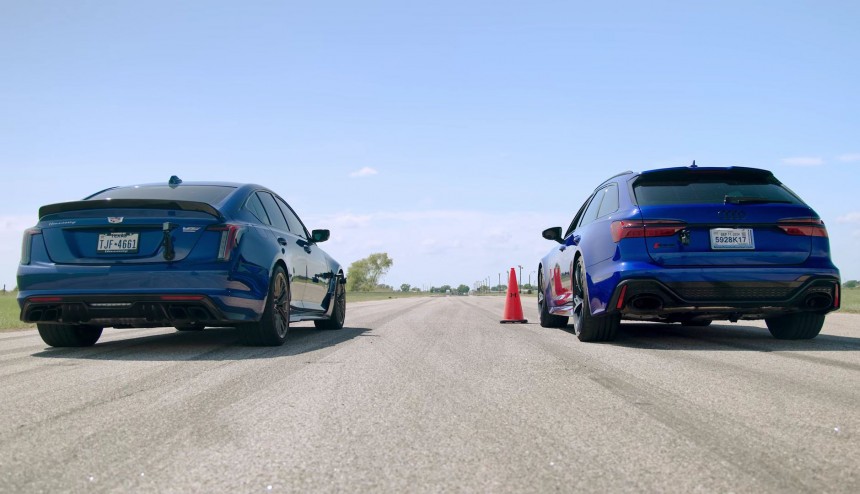Unfair is the best word to describe a race between a stock car with 621 ponies and one that packs 332 more horses than its factory rating. Similarly, it's unfair to see a quattro-equipped wagon take on a rear-drive sedan.
The differences between the H1000 CT5-V Blackwing and the RS 6 Avant in the featured video don't end here, though. Pictured at Lonestar Motorsports Park, these fellows couldn't be more different in how they shift. Audi harnesses the 4.0 TFSI with the ZF 8HP torque-converter automatic, whereas the most powerful road-going sedan from the Cadillac brand comes with either a 10-speed automatic or a 6-speed manual. This Caddy has the latter.
Under the skin, the CT5-V Blackwing features a rear-biased platform that premiered more than a decade ago with the 2013 Cadillac ATS. The Volkswagen Group's architecture, on the other hand, is a bit of an oddball because it's meant for longitudinal applications with front- or all-wheel drive instead of rear- or all-wheel-drive.
Even so, the MLB Evo-based RS 6 Avant splits torque 40:60 front and rear by default. Up to 85 percent can be directed to the rear axle in case of slip, whereas the front can take 70 percent of the advertised 627 pound-feet (850 Nm) of tire-shredding twist. Obviously enough, Torsen-style quattro is the right kind of quattro, for the center diff enables a much superior all-wheel-drive system compared to the rear-axle-disconnect setup that Audi calls quattro ultra.
Tipping the scales at 4,982 pounds (2,260 kilograms), the RS 6 Avant is quite a bit heavier than Cadillac's no-nonsense sedan. The CT5-V Blackwing is rated at 4,123 pounds (1,870 kilograms) with the manual or 4,142 pounds (1,879 kilograms) with the automatic.
Launching a manual-equipped performance car with 659 pound-feet (893 Nm) on deck is hard enough, but 966 pound-feet (1,310 Nm) in on a wholly different level of hard. There's a reason why the folks at Hennessey Performance Engineering advertise only the automatic's quarter-mile time, that being 10.1 seconds.
Be that as it may, the stick-shift H1000 CT5-V Blackwing somehow launches better than a performance-oriented longroof with all-wheel drive. Its lower curb weight and relentless torque delivery from that supercharged 6.2-liter small block results in an easy quarter-mile victory, and the modified Cadillac also makes the Audi look slow from a rolling start.
Alex Roys from Hennessey Performance Engineering didn't share any numbers for either showdown, but looking at the bigger picture, neither vehicle was designed by its respective manufacturer to excel at shaming 2,000-horsepower R35s at the drag strip. With Audi currently developing a hybridized replacement for the RS 6 Avant, chances are that it's going to be slower due to the added weight.
That's exactly what happened to BMW with the G90-generation M5, whose additional pounds from the plug-in hybrid system are detrimental to off-the-line acceleration. Think 5,390 pounds (2,445 kilograms), with zero to 60 miles per hour (97 kilometers per hour) doable in 3.4 seconds compared to anything between 3.2 and 2.9 for the lighter F90.
Under the skin, the CT5-V Blackwing features a rear-biased platform that premiered more than a decade ago with the 2013 Cadillac ATS. The Volkswagen Group's architecture, on the other hand, is a bit of an oddball because it's meant for longitudinal applications with front- or all-wheel drive instead of rear- or all-wheel-drive.
Even so, the MLB Evo-based RS 6 Avant splits torque 40:60 front and rear by default. Up to 85 percent can be directed to the rear axle in case of slip, whereas the front can take 70 percent of the advertised 627 pound-feet (850 Nm) of tire-shredding twist. Obviously enough, Torsen-style quattro is the right kind of quattro, for the center diff enables a much superior all-wheel-drive system compared to the rear-axle-disconnect setup that Audi calls quattro ultra.
Tipping the scales at 4,982 pounds (2,260 kilograms), the RS 6 Avant is quite a bit heavier than Cadillac's no-nonsense sedan. The CT5-V Blackwing is rated at 4,123 pounds (1,870 kilograms) with the manual or 4,142 pounds (1,879 kilograms) with the automatic.
Be that as it may, the stick-shift H1000 CT5-V Blackwing somehow launches better than a performance-oriented longroof with all-wheel drive. Its lower curb weight and relentless torque delivery from that supercharged 6.2-liter small block results in an easy quarter-mile victory, and the modified Cadillac also makes the Audi look slow from a rolling start.
Alex Roys from Hennessey Performance Engineering didn't share any numbers for either showdown, but looking at the bigger picture, neither vehicle was designed by its respective manufacturer to excel at shaming 2,000-horsepower R35s at the drag strip. With Audi currently developing a hybridized replacement for the RS 6 Avant, chances are that it's going to be slower due to the added weight.
That's exactly what happened to BMW with the G90-generation M5, whose additional pounds from the plug-in hybrid system are detrimental to off-the-line acceleration. Think 5,390 pounds (2,445 kilograms), with zero to 60 miles per hour (97 kilometers per hour) doable in 3.4 seconds compared to anything between 3.2 and 2.9 for the lighter F90.
















